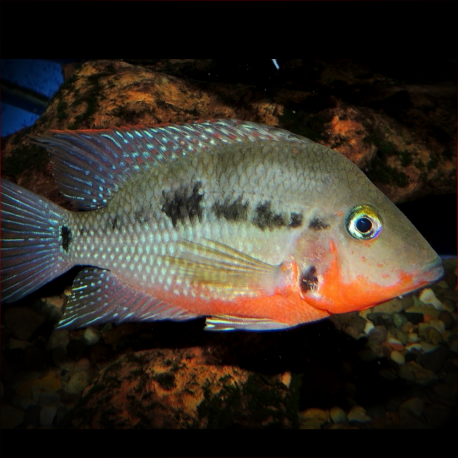More info
Datasheet
| Minimum Tank Size | 120 litres / 31.70 US gallons |
| Maximum Size | 12.0cm / 4.72inches |
| Temperature | 20°C / 68.00°F - 32°C / 89.60°F |
| Hardness | 2.02dgH / 36ppm - 15.02dgH / 268ppm |
| pH | 6.5-8.5 |
General Description
The Firemouth Cichlid, scientifically known as Thorichthys Meeki, is identified by its bright red or orange underside of the head, more prominent in adults. Belonging to the family Cichlidae, this species is a popular aquarium fish that is commercially bred for the trade. The Thorichthys genus is characterized by specific traits like soft dorsal and anal fins without scales, a unique caudal fin shape, and specific color patterns.
Aquarium Setup
To house the Firemouth Cichlid, a tank size of at least 120 liters is recommended with suitable decor such as ceramic flowerpots, plastic piping, and rocks for cover. A natural-looking setup with sandy substrate, rocks, driftwood, and caves provides ideal habitat. Water quality is crucial, ensuring a biologically mature aquarium with hardness ranging from 36-268ppm, a pH level of 6.5-8.5, and a temperature between 20-32°C.
Behaviour
The Firemouth Cichlid is not overly aggressive but can be territorial during breeding. It may consume smaller fishes and benefits from being kept with similarly-sized Central American cichlids to allow for the formation of territories. Groups of peaceful upper-water dwelling fish like Poecilia and Xiphophorus can also be compatible tankmates. Thorichthys species are social and thrive in groups of eight or more individuals.
Feeding and Diet
Thorichthys species are omnivores, primarily feeding on benthic organisms like small crustaceans, invertebrates, mollusks, and detritus in the wild. In captivity, they accept a varied diet comprising high-quality prepared foods, live or frozen larvae, and products rich in vegetable matter like Spirulina. Homemade gelatine-bound recipes with a mix of fish food, shellfish, fruits, and vegetables are beneficial for their nutrition.
Reproduction & Dimorphism
The Firemouth Cichlid is a biparental, monogamous substrate spawner that breeds easily in the right conditions. Good diet and maintenance are crucial for spawning success. Adult males grow larger, develop extended fin filaments, and display more intense coloring compared to females, especially during breeding. Spawning involves the female laying eggs while the male fertilizes them, with parental care continuing after hatching.
Habitat and Distribution
Naturally found in various lowland biotopes with diverse water conditions in Mexico, Belize, and Guatemala, the Firemouth Cichlid inhabits shallow, clear-to-muddy waters with substrates of sand, mud, or limestone. It coexists with other cichlid species and various freshwater organisms, showcasing adaptability to different aquatic environments. Additionally, naturalized populations exist in Hawaii, Puerto Rico, Arizona, and Florida in the USA.

